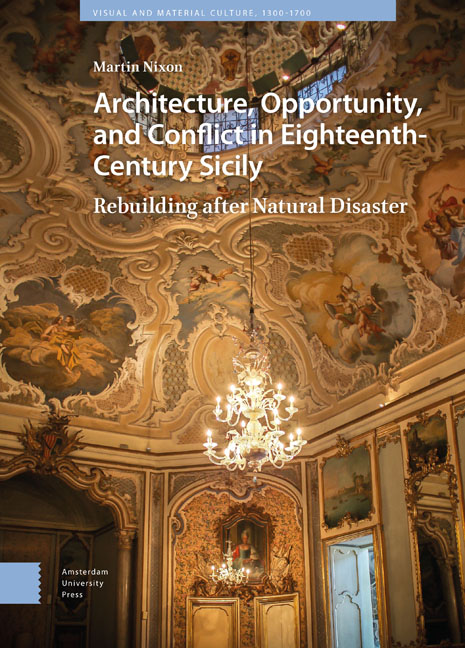 Architecture, Opportunity, and Conflict in Eighteenth-Century Sicily
Architecture, Opportunity, and Conflict in Eighteenth-Century Sicily Book contents
- Frontmatter
- Contents
- List of illustrations
- Acknowledgments
- Introduction: The Val di Noto Rebuilding: Disaster and Opportunity
- 1 Sicily as a Colonial Possession c. 1600–1750: Subordination and Resistance
- 2 The Hexagonal Towns of Avola and Grammichele : Urbanism, Fortification, and Coercion
- 3 The Palaces of Noto: Ornament, Order, and Opportunism
- 4 The Palazzo Biscari in Catania: Lightness, Refinement, and Distinction
- 5 The Palazzo Beneventano in Scicli: Trauma and Violence
- 6 The Palaces of Ragusa: Abundance, Famine, and the Grotesque
- Conclusion
- Glossary
- Bibliography
- Index
Conclusion
Published online by Cambridge University Press: 24 November 2023
- Frontmatter
- Contents
- List of illustrations
- Acknowledgments
- Introduction: The Val di Noto Rebuilding: Disaster and Opportunity
- 1 Sicily as a Colonial Possession c. 1600–1750: Subordination and Resistance
- 2 The Hexagonal Towns of Avola and Grammichele : Urbanism, Fortification, and Coercion
- 3 The Palaces of Noto: Ornament, Order, and Opportunism
- 4 The Palazzo Biscari in Catania: Lightness, Refinement, and Distinction
- 5 The Palazzo Beneventano in Scicli: Trauma and Violence
- 6 The Palaces of Ragusa: Abundance, Famine, and the Grotesque
- Conclusion
- Glossary
- Bibliography
- Index
Summary
In this book I have adopted a materialist approach to engage with the complexity of the Val di Noto rebuilding. Instead of presenting the towns as principally exercises in putatively rational and harmonious baroque planning, I examined how different architectural commissions in the Val di Noto—hexagonal urban layouts, palace facades and their decoration, and the palace interior of the ballroom—tied with the interests, insecurities, and fears of their aristocratic patrons.
Chapter Two examined how the hexagonal towns of Avola and Grammichele operated in remaking territory. Treatises such as those by Leon Battista Alberti and Giovan Biagio Amico promote geometry as architecture's principal generator. Although scholars of Early Modern European architecture such as Martha Pollak implicate geometry within fortifications and military power, they still present geometry as an uncomplicated, universal set of rational laws. In contrast, I analysed the hexagonal layouts and the reshaped environment in terms of territorialisation rather than as simple exercises in ideal urbanism. The feudal status of Avola and Grammichele's owners was justified by claims to noble lineage, but after the earthquake, their dominance of the territory was reasserted in their ability to create of the hexagonal layouts.
In Avola and Grammichele, the purportedly universal truth and rationality of the exercise of geometry supported the barons’ claim to superiority. The towns’ overtly geometric urbanism associated their rulers with access to the supposedly rational. It masked unequal power relations between the absentee barons and the towns’ inhabitants. Carlo Maria Carafa's writing on rulership evokes universal laws to justify this feudal system. His writing seeks to naturalise this dominance, emphasising the prince's place at the political centre, supported by divine order and ideal mathematics. The employment of an ‘ideal order’—supposedly inscribed in the cosmos through geometry—gives the barons a claim to a putative universal and superior truth.
Chapter Three discussed family alliances and rivalries in the rebuilding of Noto and related this to marginality and effects of restraint and luxury in the town's palace facades. The changes of decision in Noto's rebuilding create a complex narrative, but these changes reveal that there was often resistance to imposed decisions. The government was not able to impose its decisions from afar. Noto's aristocrats frequently ignored official rulings such as Asdrubale Termini's recommendation to return to the old site.
- Type
- Chapter
- Information
- Architecture, Opportunity, and Conflict in Eighteenth-Century SicilyRebuilding after Natural Disaster, pp. 243 - 246Publisher: Amsterdam University PressPrint publication year: 2023
